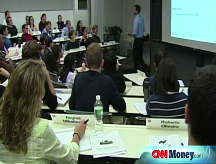Back to school in a credit crunch
Tighter lending has hurt students too. But you'll be okay as long as you borrow from the right source.
|
|
NEW YORK (Money) -- Given the recent wave of lay offs, people around the country are contemplating their next step. Hiring has slowed. Job seekers are taking an average 4.5 months today to land a new gig, according to the Bureau of Labor Statistics. So more adults are thinking now is the time to return to the classroom.
So far this year the number of GMAT tests taken by hopeful biz school students is up 15% from 2006, according to the Graduate Management Admission Council. Applications for graduate school at Arizona State University have jumped by double digits, said ASU President Michael Crow at a recent New York panel dinner of college and university presidents.
But the credit crunch has made it tougher even for students to borrow. So will grad school hopefuls be able to get a loan?
Yes, says Kal Chany, author of "Paying for College without Going Broke" and president of the Manhattan based financial aid advisory firm Campus Consultants, as long as you know where to look. "If you're willing to sign on the dotted line and you don't have a dime, you can still go to law, medical or business school."
Skip private loans. You may be tempted to first turn to the private bank you borrowed from in college. Bad idea. That company may not offer graduate loans anymore, as many have exited the market altogether. The remaining lenders have tightened standards so severely that students with credit scores below 700 often will not qualify, says Kevin Walker, president and CEO of simpletuition.com, an online student loan comparison Web site. Even students with scores above that often need a co-signer with a score at least that high - rarely the case a few years ago, he says.
What's more, you'll generally pay higher fees and interest rates on private loans than you will with federal aid. Today private rates average about 13%, four percentage points or more above federal loans, estimates Mark Kantrowitz, publisher of FinAid.org, a financial aid information Web site. They are also typically variable, meaning you'll owe more when interest rates rise.
Start with Stafford loans. Fortunately, it is now possible to fully fund graduate school without any private money. In 2006 the government began providing graduate students enough federal aid to cover the entire cost - even living and transportation expenses. This government aid charges fixed interest rates.
To secure this assistance, first complete the FAFSA, the Free Application for Federal Student Aid. Your school may also require a separate form to apply for its aid, so be sure to ask. (Graduate students are typically considered independents, so even if the aid forms require your parents' financial details, their assets generally do not lower your federal aid, says Chany.) This information is used to determine if you qualify for need-based aid, such as Perkins or subsidized (the government pays the interest while you are in school) Stafford loans. Take them if you get them.
All students, regardless of need, can borrow up to $20,500 (medical students have higher maximums) total in subsidized and unsubsidized Stafford loans. These loans come with a fixed low rate of 6.8%, although you will typically have to pay a 3-4% fee, says Walker.
Finish with PLUS loans. If you need more than that, look to a graduate PLUS loan. It charges a fixed interest rate of 7.9% if your school allows you to borrow directly from the government, or 8.5% if you must go through a private bank. (Don't be confused. You are still securing a government-backed loan, but getting it from a private company.) Your school's financial aid office can recommend lenders.
You can borrow enough money in PLUS loans to fully cover the remainder of your education, including books and living expenses. Better yet, nearly all students will be approved for this loan - no co-signer needed. "There is a credit check, but as long as you don't have adverse credit history, you will qualify," says Chany. So you cannot be 90 days or more late on a debt payment (180 days on mortgage or medical bills) or have had a foreclosure, bankruptcy or tax lien in the previous five years. If you clear that test, consider yourself fully funded. ![]()



